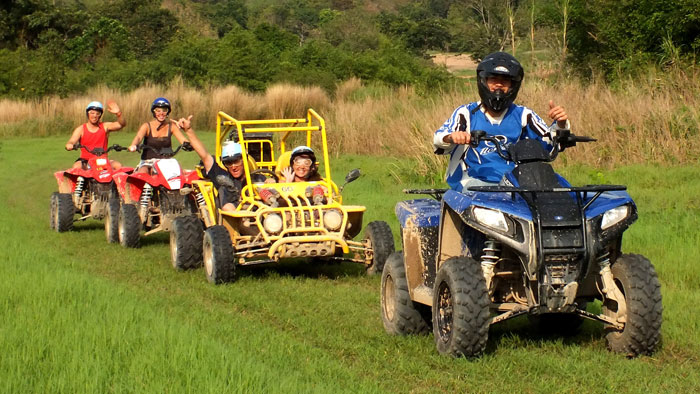Understanding the Trails: ATV Riding Tips and Techniques
Mastering the Trails: ATV Riding Tips and Techniques is a detailed guidebook made to furnish riders with the expertise and skills essential to navigate off-road surfaces with confidence and accuracy. This expertly crafted source looks into various elements of ATV riding, including correct body positioning, browsing uphill and downhill trails, grasping limited turns, maneuvering barriers, and adopting necessary safety preventative measures. Written in an expert design, this guide highlights the relevance of technique and uses practical recommendations for cyclists of all levels. With an emphasis on safety and security and skill development, Grasping the Trails is a must-have for ATV lovers aiming to enhance their riding capabilities and take on any path with skill.
Importance of Proper Body Positioning
Proper body positioning is vital for maximizing control and stability while riding an ATV. When riding off-road cars like ATVs, maintaining the appropriate body setting is important for accomplishing ideal control and stability. By positioning your body correctly, you can efficiently distribute your weight and maneuver the ATV more successfully, allowing for a more secure and extra delightful adventure.
This suggests keeping your body upright and centered over the ATV at all times. In addition, keeping your body upright permits you to much better absorb bumps and shocks, decreasing the effect on your body and enhancing total comfort.
In addition, it is vital to hold the handlebars strongly and keep your arms slightly curved. This position permits better control and ability to move, as it enables you to swiftly reply to changes in terrain or unforeseen obstacles. Maintaining your arms unwinded and somewhat curved also assists take in resonances and shocks, reducing tiredness and enhancing total control.
Tips for Navigating Uphill and Downhill Trails
When navigating uphill and downhill tracks on an ATV, riders must employ tactical techniques to securely and successfully maneuver with differing terrains. This helps to avoid the ATV from flipping backward.

Mastering Limited Transforms and Steering Barriers
To efficiently navigate limited turns and maneuver obstacles on an ATV, motorcyclists have to use reliable methods and maintain a focused approach. Furthermore, leaning ahead and gripping the handlebars firmly allows for better control over the ATV's steering. By looking in advance, cyclists can prepare for any kind of prospective difficulties and readjust their rate and body setting as necessary.
When it comes to navigating barriers, such as rocks, dropped trees, or deep ruts, cyclists need to approach them with care. Maintaining a loose grasp on the handlebars and permitting the ATV to move beneath you will help preserve equilibrium and control. These strategies, combined with method and experience, will certainly enable cyclists to have a peek at these guys with confidence browse limited turns and get rid of barriers on their ATV experiences.
Necessary Security Preventative Measures for ATV Riding
ATV bikers have to prioritize sticking to critical safety and security preventative measures to guarantee a pleasurable and secure riding experience. These security precautions are crucial in lessening the dangers associated with ATV safeguarding the cyclist and riding from prospective accidents or injuries.
In addition, it is important to have a peek at this website acquaint oneself with the ATV and its controls before riding. Examining the ATV's condition prior to each adventure is also important.

Strategies for Riding in Various Terrains
Familiarizing oneself with the techniques for riding in various terrains is essential for ATV riders to navigate various landscapes safely and effectively. Each terrain presents its very own difficulties and needs specific skills and strategies to guarantee a controlled and smooth trip.
When riding on uneven and rocky surfaces, it is vital to maintain a relaxed and balanced stance. Keeping your body versatile and loosened will permit you to keep and soak up shocks control over the ATV. Furthermore, it is necessary to preserve a stable speed and stay clear of abrupt acceleration or braking, as this can bring about loss of traction and prospective mishaps.
For muddy or sandy surfaces, it is advised to lower tire stress to increase traction. Lowering the tire stress allows the tires to grip the ground much better, protecting against the ATV from obtaining stuck. It is likewise a good idea to use a greater equipment and preserve a constant rate to stop the wheels from spinning and excavating into the surface.
When riding on high slopes or declines, it is vital to move your body weight forward or in reverse to keep equilibrium. Leaning onward while climbing up uphill will prevent the ATV from flipping backward, while leaning backward while coming down will prevent the ATV from turning ahead. It is important to make use of the suitable gears and stay clear of unexpected acceleration or stopping, as this can create loss of control and potential mishaps.
Conclusion
In final thought, grasping ATV riding needs correct body positioning, proficient navigation of uphill and downhill trails, and the capacity to steer tight turns and obstacles. By practicing these techniques and following safety and security standards, ATV cyclists can boost their abilities and enjoy the tracks to their greatest possibility.
When taking on downhill routes, motorcyclists need to move their body weight backward to preserve stability and stop the ATV from turning onward.To effectively navigate see this page limited turns and maneuver barriers on an ATV, riders must employ effective methods and preserve a focused strategy.ATV riders have to prioritize adhering to essential security precautions to guarantee a pleasurable and safe and secure riding experience. These safety precautions are vital in minimizing the risks linked with ATV securing the cyclist and riding from prospective accidents or injuries. Leaning forward while climbing uphill will avoid the ATV from flipping in reverse, while leaning in reverse while coming down will stop the ATV from turning onward.